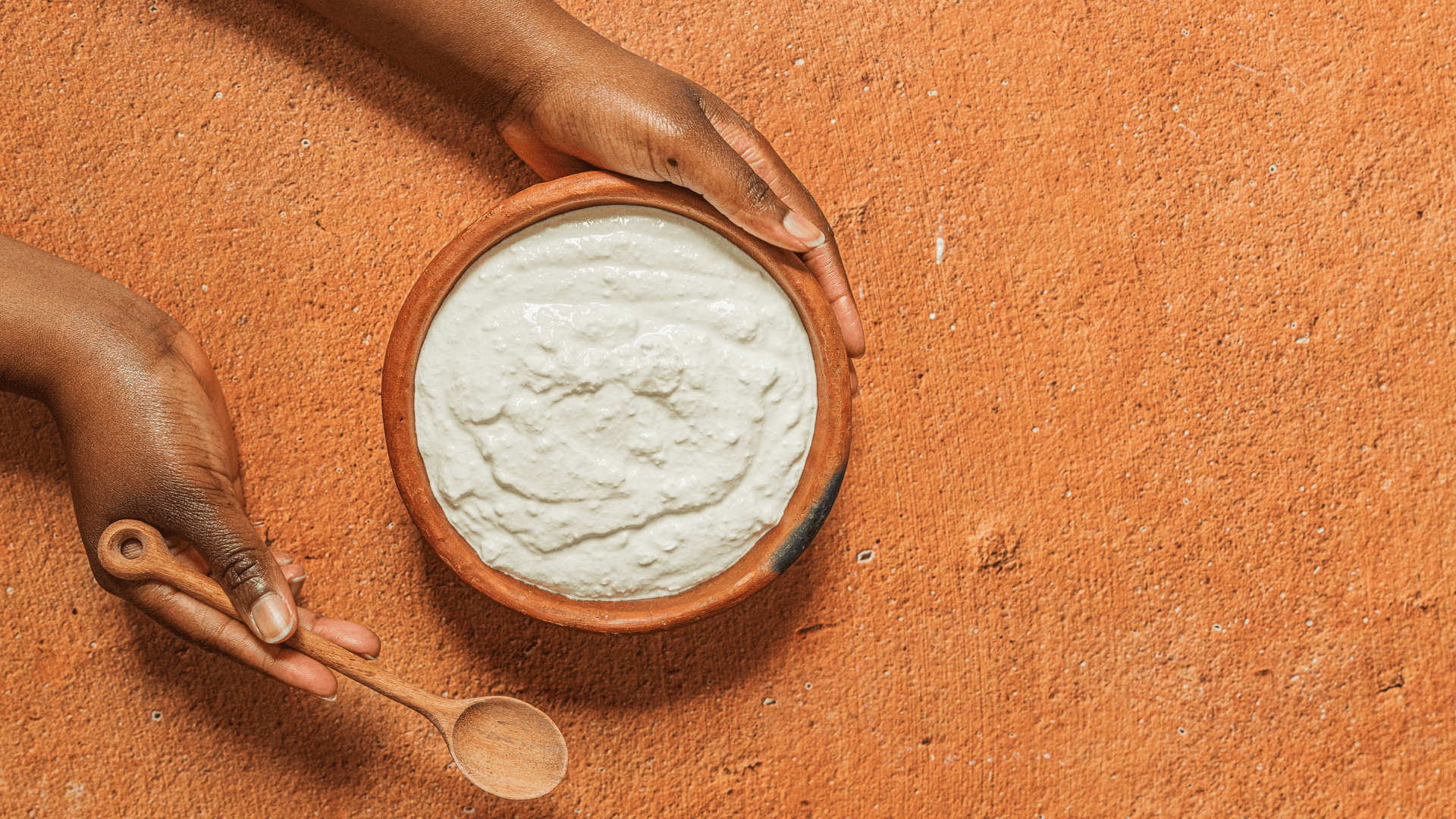I was born in Rwanda, in the land of a thousand hills. Back then, fermentation wasn’t a science we studied. It was a way of life. It was how we kept food from spoiling in the heat, how we deepened flavour, and how we stretched the little we had to feed us for many days to come. We didn’t have fridges, and neither did most of those around us. But we had time. We had sun. We had the wisdom passed through hands weathered by work and grace; the knowledge of how to let nature do what it does best. To transform.
I remember cassava roots tucked away in burlap sacks, fermenting slowly and quietly in the dark. They would soften and sour, and the sharp scent rising; not foul but promising, would signal to us that nature was at work. Once the roots were ready, we laid out the roots like offerings under the sun. When dry, we pounded them, turning them into flour. That flour gave us cassava pap. It was thick, slightly tangy and proof that good food takes time.
I still remember the thick porridge my mother made from fermented sorghum. She would soak the ground grains and let them sit, bubbling gently for days, then cook them slowly over the fire in the early morning. That porridge warmed you from the inside out, the kind of breakfast that could carry you into the hills and back again. Strong, quiet, enduring like the women who made it.
Fermentation stretched the seasons. It turned our harvest into something that could last in sacks stacked in storerooms and tucked in corners. When the rain stopped and the fresh food faded, the fermented stayed sour, strong and nourishing. It was how we held on to the abundance of the moment and made it carry us through the lean ones. A quiet preservation of plenty and a promise that nothing good would go to waste.
Fermentation didn’t just make food last. It made food taste better, bolder and more alive. It made it healing.
We weren’t alone in this. Across Africa, people were working with nature and listening to time. They weren’t rushing. They were waiting, watching and trusting. A quiet kind of magic passed down through hands that knew to be still. Our ancestors knew the power of trusting the unseen – they listened for change, and they knew the best things happen when you wait.
In Ethiopia and Eritrea, teff was left to ferment until it became injera; that soft, sour, spongy bread that feels like a hug when torn by hand. In Malawi and Zambia, maize or cassava is fermented just enough to make nsima, not just for taste, but to make it easier to digest and gentler on the belly.
Even milk knew how to wait. We would buy it fresh from neighbours who kept cows, drink some with tea, and leave the rest. Never to waste but to welcome the transformation.
In Rwanda, it became Ikivuguto.
In Southern Africa, it was amasi.
In West Africa, they called it nunu.
All creamy, tart, nourishing long before we knew words like “gut-health” and “probiotics”. We just knew it worked. We knew we felt better, and that was enough.
In Nigeria and Ghana, locust beans became dawadawa; sticky, pungent and full of umami. A spoonful could lift an entire pot of soup with flavour. In the Sahel, soumbala was made the same way. It was their stock cubes, long before supermarkets existed.
Even meat and fish knew how to bow to time. In Ghana, momoni, a fermented fish paste, added mystery and depth to broths. In the Democratic Republic of Congo and in my own Rwanda, we had makayabu, salted fish dried under the sun until it almost hummed with flavour. If left long enough, it would begin to ferment subtly, taking on a gentle sourness. No one needed to call it “fermentation.” We simply knew it was good.
Our ancestors didn’t have thermometers or starter cultures. What they had was instinct and a deep trust in memory. They understood that fermentation was a relationship with time, with microbes and food itself – no additives, no shortcuts. Just patience and inherited knowledge, often passed down from mother to daughter, or woman to woman across community fires in stories and songs.
Today, I see the world falling in love with fermentation again, sourdough bread, kombucha, miso, kefir. But for us in Africa, fermentation was never lost. It simmered quietly in pots, jars and calabashes, waiting to be remembered.
As a chef, I’ve come back to it. To feed my gut, yes, but also to preserve memory. I want my son to know that his grandmother’s sour porridge isn’t outdated – it’s wise, and that fermentation is not only about gut health, it’s about listening to what nature already knows.
Fermentation, I’ve come to see, is a kind of faith. It’s the act of handing something over to time, you wait, and you believe it will come back to you better. It teaches us the same quiet lessons life does: to let go, to be patient, to honour the process. To trust that in the waiting, something good is happening. Even if we can’t see it yet.
When I stir that bubbling pot of sorghum porridge…
When I taste the tang of cassava pap…
I’m not just cooking. I’m remembering.
I’m keeping a legacy alive.
It is the story of every home where sourness was seen not as spoilage, but as a gift. It belongs to the women who stirred, waited, and passed it on. To the neighbours who shared a starter, a calabash, or a quiet word of wisdom. To the friends who sent fermented locust beans across borders so I could taste a piece of their home in mine.
Today, I invite others in, not just to try fermented food, but to understand it. To taste what patience, wisdom, and memory feel like on the tongue. Whether you’re African or not, there’s room at this table. Whether you grew up with cassava pap or sourdough, Ikivuguto or kombucha – this story belongs to you too.
Because at its heart, fermentation isn’t just about gut health. It’s about trust. It’s about faith in transformation. It’s about connection.
So when I cook with dawadawa, or pour warm sorghum porridge into my son’s bowl, I think of my mother. I think of my friend in Ghana. I think of all the hands that stirred before mine and all those yet to come.
We’re not just feeding bodies.
We’re feeding history.
We’re feeding the future, and we’re doing it together.
Fermented sorghum porridge
Ingredients
- 1 cup sorghum flour (or ground whole sorghum)
- 3 cups lukewarm water (for fermentation)
- 2 cups water (for cooking)
- Pinch of salt or sugar or sweetener of your choice (optional)
- Toppings: peanut butter, milk, chocolate, or fruits of your choice – we use berries
To ferment:
Begin 1 – 2 days ahead in a hot climate and up to 4 days in colder climates, or depending on how tangy you want it. In a clean bowl, whisk together the sorghum flour and lukewarm water until smooth. Cover with a clean cloth or loose lid to allow air flow but keep insects out. Leave it in a warm place for 24 to 48 hours or longer, and stir once a day. You’ll notice bubbles and a slightly sour smell – that means it’s fermenting well!
How to cook:
In a pot, bring 2 cups of water to a boil, and stir your fermented mixture – it might have separated a little. Slowly pour the fermented mixture into the boiling water, stirring constantly to avoid lumps. Cook on low to medium heat, continuously stirring for about 15 – 20 minutes, until thick and smooth. Add a pinch of salt or sugar, depending on your preference – some people enjoy it plain and sour. Serve it hot with your preferred toppings. Enjoy!



Well documented indegenous knowledge.
Worth documenting Livhuwani for generations to come require this invaluable scroll .
I love the storytelling in this article! I love that fermented food are becoming a key focus again but it also great to remember the history of the ones who taught us about fermentation through necessity.
Thank you for sharing so much knowledge that can only be shared through generations. Such a rich history and glad to see it’s still be kept alive for the world to witness.